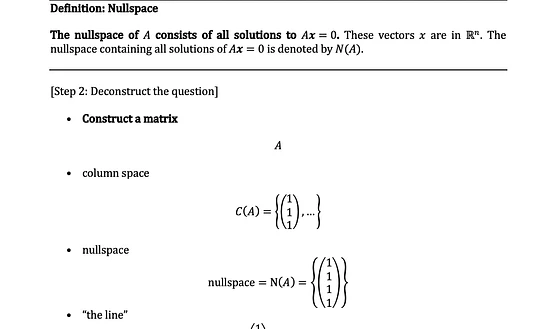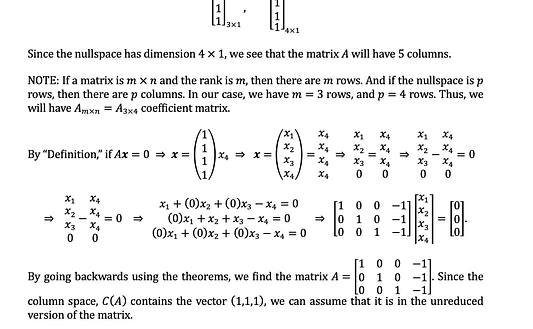Construct a Matrix with Given Column Space and Nullspace (Step-by-Step Proof)
Title: Construct a Matrix with Given Column Space and Nullspace (Step-by-Step Proof)
In this walkthrough, we show how to construct a matrix whose column space contains (1,1,1) and whose nullspace is the line of multiples of (1,1,1,1).
Step 1: Understand the Problem
We want:
-
Column space to contain the vector (1,1,1)
-
Nullspace to be the set of all scalar multiples of (1,1,1,1)
This means we are looking for a matrix A such that:
-
A * x = 0 has solution space spanned by (1,1,1,1)
-
The matrix A has 3 rows (since the column vector has 3 entries)
-
The matrix A has 4 columns (since the nullspace vector has 4 components)
Step 2: Definitions
Column Space: All linear combinations of the columns
Nullspace: All solutions to A * x = 0
So x = t(1,1,1,1) is the general solution of the homogeneous system.
Step 3: Deconstruct and Solve
We assume:
x = (1,1,1,1)t
So, x₁ = x₂ = x₃ = x₄
This gives:
-
x₁ - x₂ = 0
-
x₂ - x₃ = 0
-
x₃ - x₄ = 0
Which gives us a system of equations:
x₁ - x₂ = 0
x₂ - x₃ = 0
x₃ - x₄ = 0
Written in matrix form:
[ 1 -1 0 0 ]
[ 0 1 -1 0 ]
[ 0 0 1 -1 ]
Thus, a correct matrix A is:
A = [ 1 0 0 -1
0 1 0 -1
0 0 1 -1 ]
This has:
-
Column space containing (1,1,1)
-
Nullspace spanned by (1,1,1,1)
Step 4: Validation
Any vector in the nullspace must satisfy A * x = 0.
Let x = (1,1,1,1), then:
A * x = [1 -1 0 0]·x = 1 - 1 = 0
[0 1 -1 0]·x = 1 - 1 = 0
[0 0 1 -1]·x = 1 - 1 = 0
✅ Valid
And since (1,1,1) can be expressed as a linear combination of the columns, it's in the column space.
Conclusion
One valid matrix is:
A = [ 1 0 0 -1
0 1 0 -1
0 0 1 -1 ]
This matches the conditions exactly. There are infinitely many matrices that can satisfy these conditions, but this form is simplest and easily validated.
—
This lesson aligns with Chapter 3.2 in Strang’s Linear Algebra (4th ed.). Always cite sources and avoid shortcut tools like AI or uncredited platforms during exams unless explicitly allowed.
Visit:
https://author-jonathan-david-shop.fourthwall.com for more STEM guides.
Subscribe for live lessons and study advice: https://www.youtube.com/@AuthorJonD


